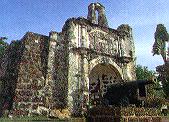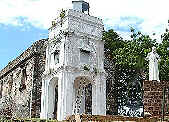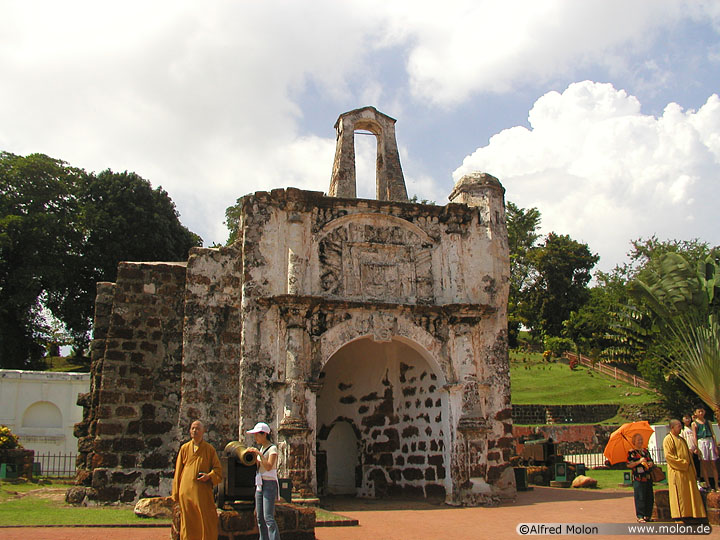
A BRIEF HISTORY
Malacca was founded by a fleeing prince from Sumatra
in 14th century, it developed into a major trading port
for ships from India and China. As the Melaka Sultanate
flourished, the Portuguese conquered Malacca in 1511.
Later the Dutch took over in 1641 until much later the
British empire ruled Malacca. The state finally obtained
independence with the then "Malaya states"
in 1957. Today, one will find many remnants of the glorious
past dated back more than 500 years ago.
----------------------------------------------------------------------------------------
HISTORICAL PLACES
A replica of the Melaka Sultanate palace was reconstructed
at the foot of St. Paul's Hill. The design is based
on the description of the palace from the sixteenth-century
'Malay Annals,' or 'Sejarah Melayu.' It is the only
building of its kind in Malaysia, and it provides a
rare glimpse of the ancient Malay kingdom that once
flourished here. The palace houses the Malacca Cultural
Museum, which includes many artifacts of that kingdom.

Melaka Sultanate palace
----------------------------------------------------------------------------------------

St. Paul Church
On top of St. Paul's Hill is the St. Paul's Church,
once the prayer house of the Portuguese Catholics, then
turned into burial ground for their noble dead by the
Dutch. The tombstones have Latin and Portuguese inscriptions
on them. St. Francis Xavier was buried here in 1553
before his body was moved to Goa in India.
----------------------------------------------------------------------------------------

After the Portuguese captured Melaka, they built a fortress
to defend themselves. The fortress, called A'Famosa
suffered severe destruction during the Dutch invasion.
What's left today is just the entrance walls, still
well preserved till today
----------------------------------------------------------------------------------------
OTHER HISTORICAL AND INTERESTING SITES :
Baba and Nyonya Heritage Museum. 'Straits
Chinese' or the Baba and Nyonya , are Chinese of noble
descendants that have adopted much of the Malay culture
into theirs. The public can now review the heirloom
unique to this heritage at private museum run by the
Babas and Nyonyas of Malacca. Floral and pictorial motifs
grace parts of the front of the house whilst the interior
is adorned with intricately carved fittings finished
in gold leaf.
Hang Jebat and Hang Kasturi's mausoleum.
Two of the Malacca Sultanate's well-known warriors and
champion of justice. Hang Jebat was unceremoniously
killed by Hang Tuah in a duel of honour that lasted
3 days and 3 nights. He was killed in the name of justice
to avenge the sultan's hasty punishment against Hang
Tuah for a crime he didn't commit.
Hang Tuah's well is located in Kampung
Duyong where Hang Tuah was born and spent his childhood
among four of his good friends who would later become
the famous warriors of Malacca Sultanate. The well is
said to be the abode of his soul which takes the apparition
of a white crocodile. For a commoner to catch the glimpse
of Hang Tuah is hardly likely. It is said that the holy
among us can ever hope to see the apparition.
Jonker's Street, once the richman's street is now a
living proof of Malacca's rich baba-nyonya heritage.
The buildings are immaculately constructed with elaborate
carvings on its pillars and walls. The street is also
famous for its antique shops.
Maritime Museum is constructed after
'Flora De La Mar', the Portuguese ship
that sank off the Coast of Malacca on its way to Portugal.
With its hull laden with invaluable treasures seized
from Malacca, the ship was doomed from existence had
it not for the efforts to Malacca's heritage. At the
museum, visitor can get a closer look at Malacca from
the famed Malay Sultanate of the 14th century to the
Portuguese era, the Dutch era and the British era. There
are exhibits of foreign ships that had once called at
the port of Malacca during the height of its maritime
hegemony.
Memorial Hall (1912), the landmark
where the nation's first prime minister announce proclamation
of independence from the British empire. It has been
preserved with archive pictures of the country's struggle
to attain independence.
Portuguese Square has a mild affinity
to Portugal and known to be 'Mini Lisbon' in Malacca.
Located within the Portuguese Settlement, the square
is the culmination of Portuguese culture in its full
splendour and colours. One will also find authentic
Portuguese restaurants at the square.
Sam Po Kong Temple was constructed
in dedication to Admiral Cheng Ho. The temple was named
after a fish that miraculously saved the admiral's ship
from sinking after it had been hit by a storm enroute
to Malacca from China. The fish mysteriously placed
itself against a damaged hull preventing the ship from
taking on water.
Sri Poyyatha Vinayagar Moorthi Temple is one of the
first Hindu temple built in the country at the turn
of the century. It was built on the plot given by the
Dutch.
St. Francis Xavier's Church was built
in 1849 by a frenchman, Reverend Farve. The Gothic towered
church is dedicated to St. Francis Xavier, well-remembered
for his missionary work spreading Catholicism to South
East Asia in the 16th century.
St. John's Fort was rebuilt by the
Dutch during the third quarter of the 18 th century,
the fort was once a private Portuguese chapel dedicated
to St. John the Baptist. The fort has an interesting
feature in that its gun embrasures face inland as during
that time, attacks on Malacca came mainly from the land
instead of from the sea.
St. Peter's Church was built in 1710
by the Portuguese descendants and comprising an architectural
mix of the Oriental and Occidental.